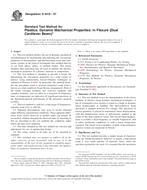We need your consent to use the individual data so that you can see information about your interests, among other things. Click "OK" to give your consent.
ASTM D5418-07
Standard Test Method for Plastics: Dynamic Mechanical Properties: In Flexure (Dual Cantilever Beam)
STANDARD published on 15.3.2007
The information about the standard:
Designation standards: ASTM D5418-07
Note: WITHDRAWN
Publication date standards: 15.3.2007
SKU: NS-31096
The number of pages: 4
Approximate weight : 12 g (0.03 lbs)
Country: American technical standard
Category: Technical standards ASTM
Annotation of standard text ASTM D5418-07 :
Keywords:
dual cantilever, dynamic mechanical rheological properties, linear displacement, modulus (storage, viscous, loss modulus, and complex), tan delta, viscoelastic behavior, ICS Number Code 83.140.01 (Rubber and plastic products in general)
Additional information
| Significance and Use | ||||||||
|
This test method provides a simple means of characterizing the thermomechanical behavior of plastic compositions using a very small amount of material. Since small test specimen geometries are used, it is essential that the specimens be representative of the material being tested. The data obtained can be used for quality control and/or research and development purposes. For some classes of materials, such as thermosets, it can also be used to establish optimum processing conditions. Dynamic mechanical testing provides a sensitive means for determining thermomechanical characteristics by measuring the elastic and loss moduli as a function of frequency, temperature, or time. Plots of moduli and tan delta of a material versus these variables can be used to provide a graphic representation indicative of functional properties, effectiveness of cure (thermosetting-resin systems), and damping behavior under specified conditions. This test method can be used to assess the following: 5.3.1 The modulus as a function of temperature or aging, or both, 5.3.2 The modulus as a function of frequency, 5.3.3 The effects of processing treatment, including orientation, induced stress, and degradation of physical and chemical structure, 5.3.4 Relative resin behavioral properties, including cure and damping, 5.3.5 The effects of substrate types and orientation (fabrication) on elastic modulus, and 5.3.6 The effects of formulation additives that might affect processability or performance. Before proceeding with this test method, refer to the specification of the material being tested. Any test specimen preparation, conditioning, dimensions, or testing parameters, or combination thereof, covered in the relevant ASTM material specification shall take precedence over those mentioned in this test method. If there are no relevant ASTM material specifications, then the default conditions apply. |
||||||||
| 1. Scope | ||||||||
|
1.1 This test method outlines the use of dynamic mechanical instrumentation for determining and reporting the viscoelastic properties of thermoplastic and thermosetting resins and composite systems in the form of rectangular bars molded directly or cut from sheets, plates, or molded shapes. The elastic modulus data generated may be used to identify the thermomechanical properties of a plastics material or composition. 1.2 This test method is intended to provide a means for determining the viscoelastic properties of a wide variety of plastics using nonresonant, forced-vibration techniques as outlined in Practice D 4065. In particular, this method identifies the procedures used to measure properties using what is known as a dual-cantilever beam flexure arrangement. Plots of the elastic (storage) modulus, loss (viscous) modulus, and complex modulus, and tan delta as a function of frequency, time, or temperature are indicative of significant transitions in the thermomechanical performance of the polymeric material systems. 1.3 This test method is valid for a wide range of frequencies, typically from 0.01 to 100 Hz. 1.4 Apparent discrepancies may arise in results obtained under differing experimental conditions. These apparent differences from results observed in another study can usually be reconciled, without changing the observed data, by reporting in full (as described in this test method) the conditions under which the data were obtained. 1.5 Test data obtained by this test method are relevant and appropriate for use in engineering design. 1.6 The values stated in SI units are to be regarded as standard. This standard does not purport to address all of the safety concerns, if any, associated with its use. It is the responsibility of the user of this standard to establish appropriate safety and health practices and determine the applicability of regulatory limitations prior to use. Note 1There is no known ISO equivalent to this standard. |
||||||||
| 2. Referenced Documents | ||||||||
|
We recommend:
Technical standards updating
Do you want to make sure you use only the valid technical standards?
We can offer you a solution which will provide you a monthly overview concerning the updating of standards which you use.
Would you like to know more? Look at this page.




 Cookies
Cookies
